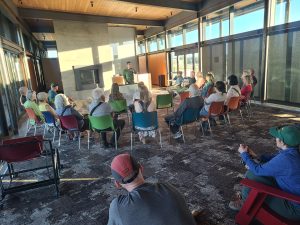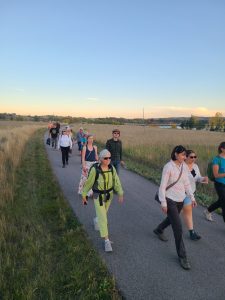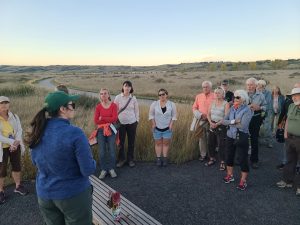
Adventures for Wilderness, Save Bow River Parks – September 25, 2024
September 26, 2024
- •
- •
- •
Text and photos by Lindsey Wallis
We were originally planning to visit a park under threat. Walking along trails that would be under water if the proposed dam on the Bow River was built and encouraging public advocacy to push back against a dam that would flood much of these two new parks. But the same morning as our adventure we received great news — the Glenbow East dam had been removed from the list of options the province was looking at to mitigate flood risk for the city of Calgary. So instead the walk became more of a celebration of these parks, which were only created by the generous donation of landowners and everyday citizens who continue to fund the operations of these parks.
We began inside the new building at Haskayne Legacy Park, where Glenbow Ranch Park Foundation CEO Jeromy Farkas shared the history of the parks’ creation and the vision to be able to connect Calgary and Cochrane with a pathway system along the river. As we took a walk in the evening glow down to the river, we walked past a lot of non-native vegetation, but closer to the river we found sections of fescue and sage. Blake Weis, Glenbow’s Conservation Program Coordinator shared information about the importance of native grasslands and how Glenbow Ranch is using cattle grazing to help manage the grassland in a similar manner to the disturbance bison would have had on the landscape. Eventually they hope to expand the program to the Haskayne Park as well.
Despite being thrilled that this park won’t be flooded, our conservation specialist Kennedy shared AWA’s concerns about building another dam on the Bow at all. “Dams inherently affect a river’s flow and function, and the Bow is already an intensely allocated, used, and fragmented watershed.” We discussed the importance of looking after our headwaters, which will not only protect us against floods, but also drought. Our rivers can provide us with so many benefits if we look after them and keep them healthy. According to Kennedy, “Substantial research has shown that implementing ecological restoration practices upstream, such as replanting riparian habitat, adding large wood and rock features, re-meandering and reopening stream channels, and restoring and retaining floodplains, wetlands, forests and beavers on the landscape are incredibly effective strategies for absorbing water and slow flows, mitigating effects downstream.”
It was heartening to see so many people show up to learn more about how to get involved to protect these wild spaces.


